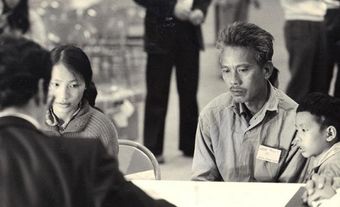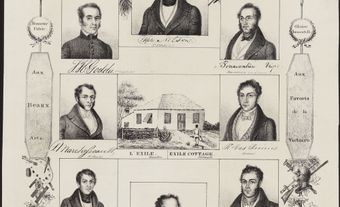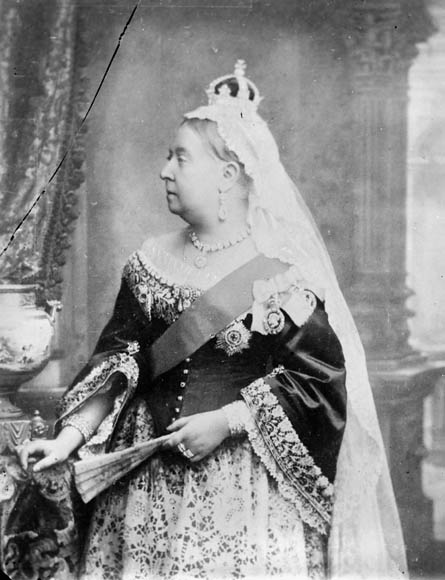
Queen Victoria (who reigned from 1837–1901) celebrated 60 years on the throne in 1897. Celebrations to honour the grand occasion — the first Diamond Jubilee — showcased the Queen’s role as “mother” of the British Empire and its Dominions, including Canada. Prime Minister Wilfrid Laurier led the Canadian delegation to the London ceremonies, while communities across Canada held their own civic celebrations in honour of the Queen.
Victoria and Canada
Victoria became queen on 20 June 1837 at the age of 18, succeeding her uncle, King William IV. She was a popular figure in Canada throughout her reign. Her birthday, 24 May, was celebrated in the Province of Canada as Victoria Day from 1845. Victoria selected Ottawa as Canada’s capital and in 1867 she played a key role in Confederation. She met with John A. Macdonald and four other Fathers of Confederation in London and expressed her support for Canadian unity and self-government.
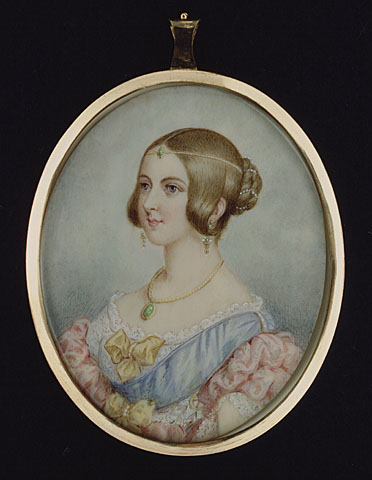
Novelist Lucy Maud Montgomery (1874–1942) recalled Canadian admiration for the Queen: “We were brought up to believe that ‘the queen,’ from babyhood to old age was a model for all girls, brides and queens to follow. In those days every home boasted a framed picture of ‘the Queen’…”
The Diamond Jubilee was therefore an occasion for popular rejoicing across Canada.
Longest-Reigning Monarch
Victoria was the first British monarch to mark the 50th (Golden) and 60th (Diamond) anniversaries of her accession to the throne with public celebrations. The 1887 Golden Jubilee emphasized Victoria’s role as the grandmother of Europe. The Jubilee parade that year was dominated by the Queen’s children and grandchildren who had married into royal houses across Europe. In contrast, the 1897 Diamond Jubilee celebrated Victoria as mother of the British Empire.
The Diamond Jubilee attracted particular acclaim because it occurred less than a year after Victoria superseded her grandfather, George III, as Britain’s longest-reigning monarch on 23 September 1896. Victoria marked that occasion privately at Balmoral castle in Scotland, recording in her journal, “People wished to make all sorts of demonstrations, which I asked them not to do until I had completed the sixty years next June.” The Diamond Jubilee was therefore an opportunity to celebrate Victoria’s status as longest-reigning monarch, in addition to marking 60 years on the throne.
The British Empire
Following the death of her husband Prince Albert in 1861, Victoria became increasingly interested in her role as part of the growth and expansion of the British Empire. She received the title of Empress of India at the suggestion of British Prime Minister Benjamin Disraeli in 1877. Although Victoria never travelled outside Europe, she emphasized her personal relationship with inhabitants of the Empire around the world, particularly indigenous peoples.
By the last decades of her reign, the predominant popular image of Victoria was as the sombre “Widow of Windsor” presiding over an Empire on which “the sun never set.” The Diamond Jubilee celebrations in London were designed to showcase this role. The prime ministers of the British Dominions, including Canada, were guests of honour.
British Celebrations
On 20 June, the 60th anniversary of her accession, Victoria attended a ceremony of Thanksgiving at St. George’s Chapel near Windsor Castle. The service included the Hymn of Praise, by Felix Mendelssohn, one of the Queen's favourite composers, which was sung by Canadian soprano Emma Albani. Victoria wrote in her journal, “How well I remember this day 60 years ago when I was called from my bed by dear Mama to receive the news of my accession.”
Tuesday 22 June, the day of the Diamond Jubilee parade in London, was declared a public holiday in Britain and “at all Foreign Places where British subjects were resident.” Three million people visited London for the celebrations. About 25,000 soldiers from the British Empire camped in tents in Hyde Park. More than a million people began taking their places along the parade route the week before the event. Seats in the hundreds of grandstands were reserved for dignitaries or sold to members of the public with the proceeds going to charity. Other spectators rented space on rooftops and balconies along the route, or even slept on the sidewalk for days to secure a space.
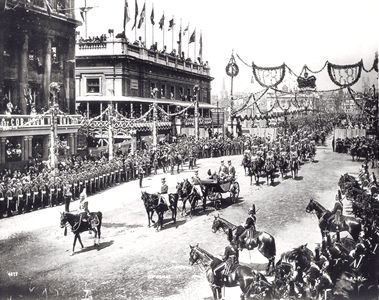
Victoria wrote on the day of the parade, “A never to be forgotten day. No one ever, I believe, has met with such an ovation as was given to me, passing through those 6 miles of streets, including Constitution Hill. The crowds were quite indescribable and their enthusiasm truly marvelous and deeply touching. The cheering was quite deafening and every face seemed to be filled with joy.”
There was a service of Thanksgiving outside St. Paul’s Cathedral, as the 78-year-old queen was unable to climb the steps into the cathedral itself.
Canadian Delegation
Prime Minister Wilfrid Laurier was knighted by Victoria in London on 21 June, receiving the honour of Knight Grand Cross in the Most Distinguished Order of St. Michael and St. George.
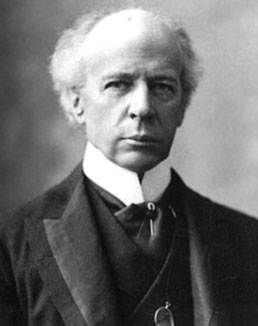
In the parade the next day, the Canadian cavalry rode five abreast at the head of the colonial procession, with Laurier following in a carriage. Behind Laurier came a detachment of the Toronto Grenadiers and Royal Canadian Highlanders. Representatives from the other parts of the Empire, as well as British and foreign royalty and finally, the Queen herself completed the parade.
Celebrations in Canada
Victoria acknowledged the congratulations of Canadians with a message to Governor General Lord Aberdeen: “From my heart I thank my beloved people. May God bless them.” Aberdeen responded, “The Queen’s most gracious and touching message, this moment received, shall be immediately made known to your Majesty’s people throughout the Dominion, and will stir afresh hearts already full. On this, this memorable day, we offer the glad tribute of loyal devotion and affectionate homage. God save and bless the Queen.” Canada’s gift to Victoria was the establishment of the Victorian Order of Nurses.
Civic celebrations took place across Canada to celebrate the Diamond Jubilee. On the 22 June holiday, streets were decorated with flags and banners, and there were celebratory fireworks displays in the evening. Newspapers noted that the Jubilee, like the annual Victoria holiday, brought together Canadians from diverse backgrounds. A Winnipeg journalist wrote that the festivities "showed how patriotism can bind in joyous and fraternal bonds elements of every nation and creed."
New music was composed in Victoria’s honour that remained popular for decades afterward. Children participated in their own Jubilee parades, with 10,000 children marching to Parliament Hill in Ottawa carrying flags.
Elizabeth's Diamond Jubilee
Victoria’s Diamond Jubilee celebrations set precedents for Queen Elizabeth II’s Diamond Jubilee in 2012. As in 1897, a service of Thanksgiving took place at St. Paul’s Cathedral. The 2012 celebrations also had an international flavour but in contrast to 1897, when the Dominion prime ministers travelled to London, Elizabeth's children and grandchildren travelled to all the Commonwealth realms in 2012.
Other aspects of the 1897 Diamond Jubilee, such as garden parties, set lasting precedents for future royal engagement with the public.

 Share on Facebook
Share on Facebook Share on X
Share on X Share by Email
Share by Email Share on Google Classroom
Share on Google Classroom
